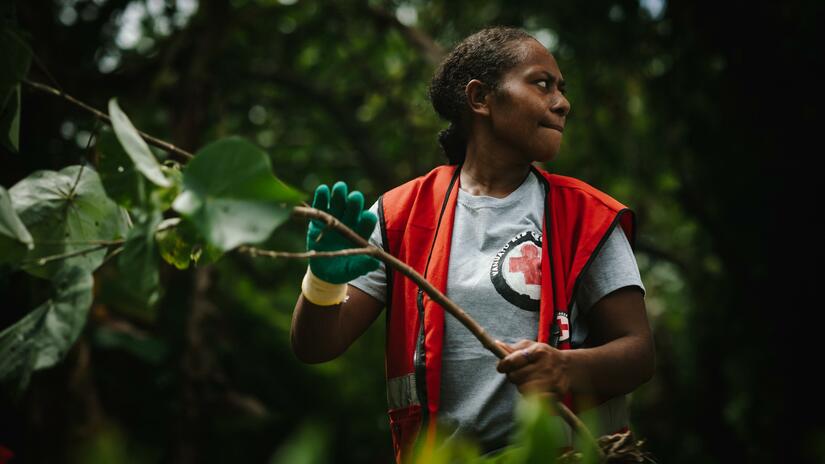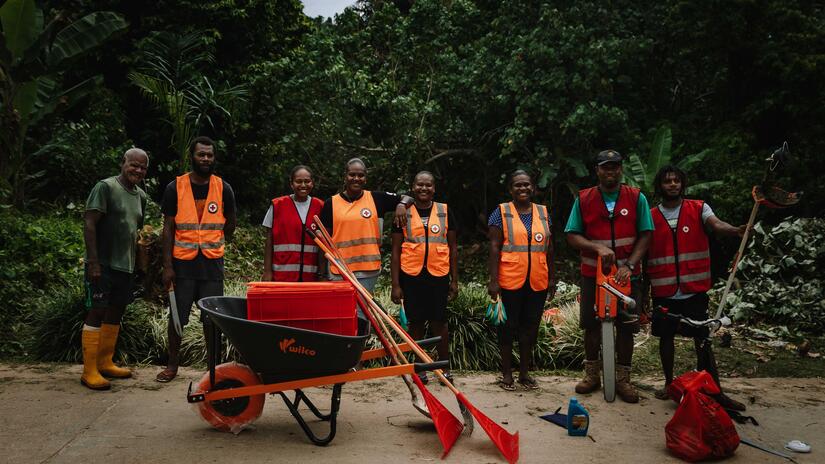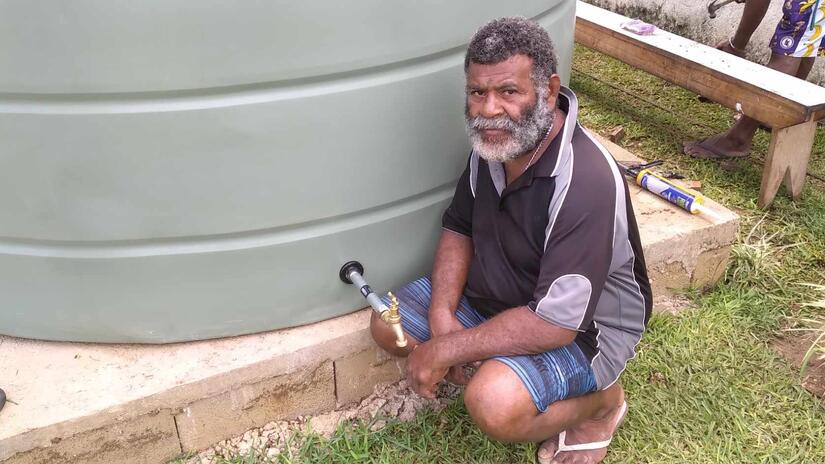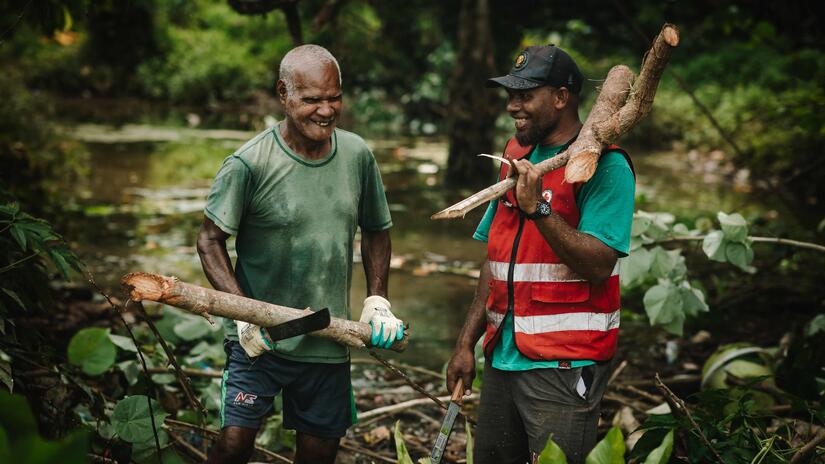Jean Philipe Clement, 58, stands ankle deep in the river that causes him and his community many sleepless nights.
As he slowly sifts through the debris left behind by the recent floods, he feels a sense of bitterness thinking about the next rainfall, knowing it will come sooner or later — likely bringing further flooding in his community.
He grips the handle of his trusty cane knife with one hand, and holds the stem of a tree branch with the other. As he swings the sharp metal blade at the base of the branch, a cracking sound can be heard as the branch is detached from the tree. It’s the only time the sounds of the mosquitoes are drowned out.
“We are trimming some of the treetops so that the sunlight can pass through and dry up whatever water is left after the floods,” he explains.
“The main cause of the flooding is the improper disposal of rubbish. People do not throw their rubbish in the right place and it’s their carelessness that is blocking the drainage and causing the flooding.”
“The stagnant water has also resulted in breeding of mosquitoes.”
‘No other option’
While the water has receded over time, it is nothing compared to the terrifying experience water pouring into doorways in nearby Solwe, a community of 900 people located in Luganville on Santo island – a 45-minute flight from Vanuatu’s capital, Port Vila.
“When it rains, the water comes from the hills and the plantations. Then it meets in the middle where Solwe is located. Because of the debris clogging up the river, this has disrupted the flow of water.”
“There is no outlet for the water and, as a result, the water has nowhere to go and levels start to rise and make its way inland, right to the houses.”
Once the flooding has reached homes, children are not able to travel to school as the roads are underwater.
“Most times the water levels reach as high as the windows of the houses. People have to enter and exit their homes using wooden planks,” says Philipe.
“They have no other option.”

Tiffanie Boihilan, 27, is one of the Red Cross volunteers who helped with the riverbed clean up, which aims to ensure that debris and vegetation in the riverbed doesn’t block water flow and cause flooding in the nearby village of Solwe.
Photo: Nicky Kuautonga/IFRC
Youth taking action
Just as his hopes for finding a solution for the frequent flooding was ebbing, Vanuatu Red Cross youth volunteers decided to take action.
Vanuatu Red Cross youth volunteers in Solwe completed training in ‘Y-Adapt’, a curriculum for young people consisting of games and activities designed to help them understand climate change and to take practical action to adapt to the changing climate in their community.
From this, they took the initiative to help people like Philipe prepare for the next rainfall – by clearing debris from the river and trimming treetops to let sunlight dry up stagnant water.
Through the support of the IFRC and Japanese Red Cross, the volunteers completed the Y-Adapt programme and were able to purchase a brush cutter, chain saw, rakes, wheelbarrow and gloves to help with their clean-up campaign.
“If we continue to clean the debris that is disrupting the flow of water and make new drainages, the water will flow out to the river and not straight into people's homes,” says Tiffanie Boihilan, 27, one of the Red Cross volunteers living in Solwe.
Y-Adapt encourages youth to focus on low cost interventions that don’t require large-scale investment or technology to implement but that can nonetheless reduce the impacts of extreme-weather events.

Members of the clean up crew stand behind the wheelbarrow, rakes, shovels and other tools they bought in order to clear vegetation and garbage from the river that runs near their town.
Photo: Nicky Kuautonga/IFRC
‘If we are lucky’
In nearby Mango Station, a similar story is unfolding, though under very different conditions. Here, the sky is blue and the ground is dry. Heads turn to the skies to see the slightest hint of a dark cloud that might bring rain.
On days like this, vegetable gardens are battered under the heat of the midday sun.
Animals seek out shade wherever they can. Empty buckets in each hand as community members set foot on the dry, dusty terrain bound for the nearest creek – an hour away.
Eric Tangarasi, 51, is the chief of Mango station. Married with six children, he says he hopes it will rain soon. Rain will replenish the sole water tank serving more than 900 people.
Mango station relies on the public water supply, but that has been inconsistent. On some days, there is no water at all. With the nearest river about an hour walk through rough terrain, the best and safest option for this community is rain water.
“In the community, there is a big challenge for water,” says Eric. “Sometimes there is no water for 2 or 3 days. Sometimes it can be as long as one month.”
“If we are lucky, the water supply comes on at around midnight until 2am, that’s when each household stores enough water for cooking and drinking.”
"Currently we have only one water tank for the community, and with over 900 people living here, we must use the tank sparingly making sure we leave enough for the others to use.”
Once again, the Vanuatu Red Cross youth volunteers swung into action.
As part of their Y-Adapt activities (and again with support from the IFRC and Japanese Red Cross), the Red Cross youth volunteers in Mango began to address the issues of water scarcity at the community level.
“There are 17 people living with disabilities and it is difficult for them when the water runs out,” says Pascalina Moltau, 26, is a Vanuatu Red Cross volunteer who lives in Mango community and has been part of this project from the start. “They cannot travel to the nearby creek as accessibility is a huge challenge, it is not safe for them.”
“We also must think of the elderly people. They are not strong enough to withstand the difficult terrain to get to the nearby creek and then carry water all the way back.”

Eric Tangarasi, 51, chief of Mango station, sits on the water-tank foundation built with the help of young Vanuatu Red Cross volunteers.
Photo: Nicky Kuautonga / Island Roots
After discussions within the community to find out best course of action, they purchased an additional 10,000-litre water tank to supplement the existing 6,000-litre water tank. The volunteers, together with the community, began their Y-Adapt implementation plan by building the foundation for the water tank.
“This 10,000 litre water tank will help the community with the growing demand for water,” Eric says. “We do not have to wait until midnight to store water now and we can be more able to manage water.”

